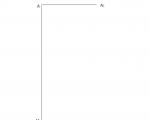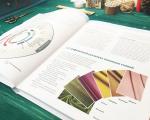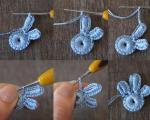Open Library - an open library of educational information. Tests test-questionnaire test-task projective Determining the sides of the horizon without a compass
He talked about his admission to the flight institute: what tasks are given to applicants during the professional selection process and how to prepare for it.
Admission is divided into entrance tests. First the medical commission. If you pass it, go to the professional selection. If you pass it, your fate will be decided by the results of the Unified State Exam. If you fail one test, you will not be allowed to take the next one.
What is included in professional selection
1. Questionnaire
There are about 500 questions to test your character. For dishonest answers, the applicant rewrites the questionnaire; if dishonesty is repeated, he is removed from the selection process.
2. Landolt Ring technique


Performance. As we can see, two rings are crossed out below under the “Test” column (the psychologist will cross them out at his discretion). Our task is to cross out rings from the form with exactly the same arrangement of cuts, and cross them out in exactly the same way as indicated by the psychologist.
With the help of this task, voluntary attention is studied and the pace of psychomotor work, performance and resistance to monotonous work that requires constant concentration are assessed. The allotted time is 5 minutes.
3. Methodology “Instrument scales”

Performance. We have 9 ammeters with different scales and division values. Our task is to find out how much each ammeter shows. Let's look at the first of them, the top left. What do we see? The number is 5. From zero to it there are five divisions. This means that the price of one division is 1. From here we see that our ammeter shows 4. Moreover, if the arrow is to the left of zero, then before the ammeter reading you need to put a “minus” sign, and if to the right, then a “plus”. And so with all ammeters. Below the ammeters there are diagrams by which we summarize the readings of the ammeters.
4. Red-black table (RBC)

We find all the numbers in this way: “24 red - 1 black, 23 red - 2 black.” That is, red ones are for decreasing, black ones are for increasing. After each number there is a letter, after finding the number you need to write it down. In our case, we should get a series of letters EEMHOI and so on.
5. Methodology “Establishing patterns”


On the left before each line there are icons “:”, “+”, “?”, “*” and so on. These symbols indicate one or more words from those in this line. Your task is to find and underline these words. The allotted time is 8 minutes.
6. Methodology “Compasses”

It is necessary to determine the direction indicated by the arrow relative to the variable coordinate system. After the subject mentally determines the direction of the compass, he must write down the designation of this direction. The subject should be warned that the form must not be rotated. The allotted time is 5 minutes.
7. Dictation 1
A large number of words are dictated at a moderately fast pace. Your task is to write as quickly and as many words as possible. The more you write down, the better. They don’t look at literacy here, the main thing is quantity. That is, instead of “milk” you can write “malako”, instead of “author” - “aftar”, “here” - “stes”. And this will be true.
8. Dictation 2
The same words are dictated as in the first dictation, but they are read in reverse: not “milk”, but “about”. Your task is to write down as many words as possible. As you hear, so write. There is no need to turn the words back around.
9. Dictation 3
A sea of words is dictated at an incredibly fast pace. Your task is to write as many words as possible as quickly as possible. Almost all. There are two tests left.
10. Conversation
This is a normal conversation, a conversation. The subject is asked why he wanted to become a pilot, and so on. It is advisable to learn the names of famous pilots, astronauts, and civil aviation holidays.
11. Device “Entrant”
You need to press certain buttons when the lights come on.

If the applicant has successfully passed the professional selection, all he has to do is provide documents and Unified State Examination results in the Russian language, mathematics and physics. The requirements for military pilots are stricter than for civilians: they also need one hundred percent vision, correct color perception, blood pressure, body mass index, height in a standing and sitting position, and the length of legs and arms are also regulated.
To determine the sides of the horizon, you need to give the compass a horizontal position, release the brake and install the device so that the northern end of the arrow coincides with the zero division of the dial: then the signatures on the dial (N, S, E and 3) will face north, south, east and west. Having determined the sides...Determining the sides of the horizon without a compass
As mentioned above, the easiest and most reliable way to determine the sides of the horizon is with a compass. But there are many other methods that you need to know in case the device malfunctions or is missing. The sides of the horizon can be determined: by the Sun; The sun and the clock; Sun and shadow; Moon; Polar...(Protection of the population and territories in emergency situations. Fundamentals of topography)
Navigation without a compass Where is north and where is south?
If you want to find the east, then stand looking north and you will receive what you are looking for in your right hand. But where is the north? How to determine at least one side of the horizon? There are many ways. For example... Orientation to the sun using a watch and... poems Direct the hour hand towards the sun, towards the golden point....(METHODOLOGY OF TRAINING AND EDUCATION IN THE FIELD OF PRESCHOOL EDUCATION. TOURISM IN KINDERGARTEN)
Compass and working with it
Rice. 85. Adrianov's compass A compass is a goniometric device that is used to measure magnetic azimuths on the ground (not on paper or a map, but in space). Compasses come in different designs, but the most widespread in our country is the compass designed in the 19th century by the Russian military...(CHILDREN AND YOUTH TOURISM)
about the compass
We are accustomed to thinking that the compass needle always faces one end north and the other south. Therefore, the following question will seem completely absurd to us: Where on the globe does the magnetic needle point north? both ends? And the question will sound even more absurd: Where on the globe is the magnetic needle...(ENTERTAINING PHYSICS. IN 2 BOOKS. BOOK 2)
Operating with spatial representations
METHODOLOGICAL SUPPORT. METHODS FOR ASSESSING PROFESSIONALLY IMPORTANT QUALITIES OF AVIATION SPECIALISTS
Methodology "Compasses"
To conduct research, it is extremely important to have a special form, pencil, stopwatch, chalkboard or auxiliary table. The auxiliary table is a demonstration drawing showing a compass. The form of the methodology shows compasses schematically (5 compasses on each of 10 lines), each compass has a designation of only one side of the world and an arrow pointing to some unmarked side of the world. Compasses are oriented in a variety of directions (“north” can be at the top, side, bottom, etc.). The subject must determine which side of the world the arrow on each compass points to, and write the answer under the compass in abbreviated form (N, E, S, 3, NE, SE, NW, SW). The subjects sign the forms and put them away.
The assistant hangs up a demonstration drawing. The experimenter gives the following instructions: “You are all familiar with the location of the cardinal directions on a compass or on a geographical map: at the top is north, opposite it, at the bottom is south, to the left of north is west, to the right is east; between north and east - northeast, between north and west - northwest, between south and east - southeast, between south and west - southwest (show in the demonstration drawing).
Now imagine that we have rotated the compass around its axis so that instead of northeast there is southwest. As you can see, the order of the cardinal directions has not changed.
On your forms (show) there are schematic images of compasses with arrows. Compasses are oriented not according to the map, but in a variety of ways, and on each compass only one of the above directions is indicated (N, S, E, 3, NW, NE, SW, SE). The compass needle can point to any of eight directions. Which one can be determined by comparing the position of the arrow with the direction given on the compass (disassemble five compasses according to the demonstration drawing: the first on your own, the rest with the help of the audience).
Your job is essentially to determine where the arrows on each compass are pointing and write the abbreviated answer underneath the compass.
It is not allowed to write the names of the cardinal directions on the forms and turn them. If you do not have time to completely solve all the tasks in 10 minutes of work, then at the experimenter’s command “Finish the work!” place a vertical line behind the last compass you viewed. If you finish work before 10 minutes, then raise your hand, I will tell you the time, which you need to write down on the form. At the command "Get ready!" take the form from the folder and a pencil, at the command “Start!” start work, at the command “Finish work!” put a vertical line and put the form under the folder. What questions do you have?
The experimenter answers the questions. The demonstration drawing is removed. The command to start work is given and the stopwatch starts. During the task, the experimenter and the assistant observe the subjects and, in cases of extreme importance, help by making a note about this in the protocol. After 10 minutes the command “Finish work!” is given.
Methodology "Compasses" The method is designed to determine spatial representations. Since there are statistically significant correlations of spatial representation indicators with the level of logical thinking, the technique is recommended for indirect assessment of the level of logical thinking. The technique is used for the purpose of professional selection.  Contents of the method: the subject is offered 25 tasks on a form, in each of which one of the 8 cardinal directions is indicated on a schematically depicted compass (N, S, E, 3, NE, N-3, SE, S-3) in a variable coordinate system and an arrow showing some other direction, which will be the subject’s task to determine relative to the variable coordinate system. After the subject mentally determines the direction of the compass, he must write down the designation of this direction. Before starting the examination, after explaining the task to the subject, it is necessary to analyze one example. The subject should be warned that the orientation form cannot be rotated along the N-S axis. The task completion time is 5 minutes. Contents of the method: the subject is offered 25 tasks on a form, in each of which one of the 8 cardinal directions is indicated on a schematically depicted compass (N, S, E, 3, NE, N-3, SE, S-3) in a variable coordinate system and an arrow showing some other direction, which will be the subject’s task to determine relative to the variable coordinate system. After the subject mentally determines the direction of the compass, he must write down the designation of this direction. Before starting the examination, after explaining the task to the subject, it is necessary to analyze one example. The subject should be warned that the orientation form cannot be rotated along the N-S axis. The task completion time is 5 minutes.  Processing The survey results are processed using a key. The following indicators are determined: the total number of viewed compasses - productivity (P); task completion time (T); number of errors (number of incorrectly marked compasses) (n); relative frequency of incorrect answers (n/p); speed of work: Stimulus material for the “Compasses” method ANSWER FORM Processing The survey results are processed using a key. The following indicators are determined: the total number of viewed compasses - productivity (P); task completion time (T); number of errors (number of incorrectly marked compasses) (n); relative frequency of incorrect answers (n/p); speed of work: Stimulus material for the “Compasses” method ANSWER FORM  Key Key |
Success rate (A): where C is the number of all compasses marked by the subject; W is the number of incorrectly marked compasses; O is the number of compasses that should have been marked; S - total number of viewed compasses.
Table 50
Sources. 1. Karelin A. Great encyclopedia of psychological tests.
Wechsler test/Children's version/Subtest 9. Koss cubes
Material Psylab.info - encyclopedia of psychodiagnostics
Subtest 9. Koss cubes
General rules:
1. The subject should sit directly in front of the table.
2. Complete tasks “A”, “B”, “C”, No. 1-4 using 4 cubes, tasks No. 5-7 - using 9 cubes.
3. Before each task, mix the cubes so that when performing out of 4 cubes, only one, and when performing out of 9 cubes, only two cubes have a red or red-white surface.
1. In front of the subject, stack the cubes as shown in the picture. Do not show the card to the subject. Leave the cubed shape “A” as a model.
2. Offer to put together 4 cubes in the same way as on the model, placing these cubes between the subject and the model. If unsuccessful, demonstrate the correct execution on the test subject's cubes, destroy them, and again offer to assemble them according to the model. Regardless of the result, move to figure “B”.
Figure "B"
1. Fold the figure “B” behind the screen. Show it to the subject in finished form and leave it as a model. Offer to put together 4 other cubes into a similar shape according to the model. If unsuccessful, demonstrate the correct execution on the test subject’s cubes, and, having destroyed them, again offer to assemble them according to the model. If you fail a second time, stop. Move to figure “C” if task “B” is completed with 1 or 2 points.
Scores: for completion on the first attempt - 2 points, on the second - 1 point.
Figure "C"
1. Place card “C” in front of the subject, saying: “Now I did exactly the same as in this picture. Look..." Make a "C" shape out of four cubes.
1. Destroy the cube figure. If unsuccessful, demonstrate the correct execution, and, having destroyed, again offer to assemble it from the picture. If you fail a second time, stop. Go to figure No. 1 if task “C” is completed by 1 or 2 points.
Scores: for completion on the first attempt - 2 points, on the second - 1 point.
Suggest task No. 1. Stop if there are 2 failures in a row (starting with task No. 1).
For children 8 years and older who are not suspected of having mental decline:
Explain and show the coloring of the cubes.
Start with a “C” shape (see above).
When completing task “C” on the 1st or 2nd attempt:
1. give an advance for “A” and “B” (4 points);
2. go to task No. 1.
If task “C” is not completed on the second attempt, return to “A” and “B” and stop.
Stop if there are two failures in a row.
Grades for tasks No. 1-7 depend on the completion time.
Grades and time limits.
Provide a stopwatch (or a watch with a second hand). Demonstration poster with the image of 50 compasses (or individual assignment forms with similar content).
Instructions
owls indicating in the form of a dash one of the 8 cardinal directions (SW, N, NE, etc.). Task: determine in which direction of the world the arrow shown on each compass is directed. You have 10 minutes to complete the task. Answers are written in the form of the names of the cardinal directions (NW, SE, S,...) in 50 circles of the answer sheet, located in the same way as compasses on the demonstration poster. Rotating an individual task form to facilitate decision making is not permitted.
The assessment is carried out in points based on the number of correct answers in accordance with the table: 


The number of correct answers of the subject is found from the reference table containing the correct answers:
Instructions The subject is asked to perceive and remember the figure by touch (in the complete absence of visual contact with it). After 1 minute, removing it from the subject’s field of view, ask him to draw this figure on paper. Remove the sheet of paper with the sketch and invite the subject to now visually (within no more than 1 minute) perceive the figure and sketch it again on paper. Perform the described operations with each of the six figures.
Analysis and interpretation of results
The quality of the task is assessed in points (from 1 to 5) according to the degree of coincidence of each figure with its two sketches (with tactile and visual perception). Points are assigned in accordance with the scale presented in the table:
The comparison results are entered into the results table.
(KTV): 
where Nav.t., Ncp.3p. - respectively, the average score for tactile and visual perception.
More on the topic: Methodology for studying the perception of spatial relationships (“Compasses”):
- 11.7. METHODOLOGY FOR STUDYING SOCIAL AND PROFESSIONAL ORIENTATIONS OF GRADUATES OF GENERAL EDUCATION SCHOOLS
- METHODOLOGY FOR STUDYING SCHOOL MOTIVATION OF PRIMARY CLASS STUDENTS
- Stepanishchev A.T. Methods of teaching and studying history: Textbook, manual for students. higher schools, institutions: In 2 hours. Part 1., 2002
- Stepanishchev A.T. Methods of teaching and studying history: Textbook, manual for students. higher schools, institutions: At 2 p.m. 2., 2002



